Surface Drilling Parameters and Drilling Optimization Techniques: Are They Useful Tools in Gas Hydrate Detection?
Abstract
:1. Introduction
2. Materials and Methods
2.1. Site Location
2.2. Methodology
3. Results
3.1. NGHP-02-23A
3.2. U1517A
4. Discussion and Interpretation
5. Conclusions
Author Contributions
Funding
Institutional Review Board Statement
Informed Consent Statement
Data Availability Statement
Acknowledgments
Conflicts of Interest
References
- Xu, C.-G.; Li, X.-S. Research Progress on Methane Production from Natural Gas Hydrates. RSC Adv. 2015, 5, 54672–54699. [Google Scholar] [CrossRef]
- Kvenvolden, K.A.; Lorenson, T.D. The Global Occurrence of Natural Gas Hydrate. Geophys. Monogr. Ser. 2000, 124, 3–18. [Google Scholar] [CrossRef]
- Kvenvolden, K.A. Methane Hydrate—A Major Reservoir of Carbon in the Shallow Geosphere? Chem. Geol. 1988, 71, 41–51. [Google Scholar] [CrossRef]
- Gabitto, J.F.; Tsouris, C. Physical Properties of Gas Hydrates: A Review. J. Thermodyn. 2010, 2010, 271291. [Google Scholar] [CrossRef] [Green Version]
- Du Frane, W.L.; Stern, L.A.; Weitemeyer, K.A.; Constable, S.; Pinkston, J.C.; Roberts, J.J. Electrical Properties of Polycrystalline Methane Hydrate. Geophys. Res. Lett. 2011, 38, 2–6. [Google Scholar] [CrossRef]
- Hamada, Y.; Hirose, T.; Saito, S.; Moe, K.; Wu, H.Y.; Tanikawa, W.; Sanada, Y.; Nakamura, Y.; Shimmoto, Y.; Sugihara, T.; et al. Equivalent Formation Strength as a Proxy Tool for Exploring for the Location and Distribution of Gas Hydrates. Mar. Pet. Geol. 2019, 108, 356–367. [Google Scholar] [CrossRef]
- Merey, Ş. Drilling of Gas Hydrate Reservoirs. J. Nat. Gas Sci. Eng. 2016, 35, 1167–1179. [Google Scholar] [CrossRef]
- Boswell, R.; Collett, T.S. Current Perspectives on Gas Hydrate Resources. Energy Environ. Sci. 2011, 4, 1206–1215. [Google Scholar] [CrossRef]
- Li, X.S.; Xu, C.G.; Zhang, Y.; Ruan, X.K.; Li, G.; Wang, Y. Investigation into Gas Production from Natural Gas Hydrate: A Review. Appl. Energy 2016, 172, 286–322. [Google Scholar] [CrossRef] [Green Version]
- McConnell, D.R.; Zhang, Z.; Boswell, R. Review of Progress in Evaluating Gas Hydrate Drilling Hazards. Mar. Pet. Geol. 2012, 34, 209–223. [Google Scholar] [CrossRef]
- Wang, F.; Zhao, B.; Li, G. Prevention of Potential Hazards Associated with Marine Gas Hydrate Exploitation: A Review. Energies 2018, 11, 2384. [Google Scholar] [CrossRef] [Green Version]
- Kvalstad, T.J.; Andresen, L.; Forsberg, C.F.; Berg, K.; Bryn, P.; Wangen, M. The Storegga Slide: Evaluation of Triggering Sources and Slide Mechanics. Mar. Pet. Geol. 2005, 22, 245–256. [Google Scholar] [CrossRef]
- Hornbach, M.J.; Lavier, L.L.; Ruppel, C.D. Triggering Mechanism and Tsunamogenic Potential of the Cape Fear Slide Complex, U.S. Atlantic Margin. Geochem. Geophys. Geosyst. 2007, 8, 1722. [Google Scholar] [CrossRef] [Green Version]
- Li, L.; Lei, X.; Zhang, X.; Sha, Z. Gas Hydrate and Associated Free Gas in the Dongsha Area of Northern South China Sea. Mar. Pet. Geol. 2013, 39, 92–101. [Google Scholar] [CrossRef]
- Nair, V.C.; Gupta, P.; Sangwai, J.S. Gas Hydrates as a Potential Energy Resource for Energy Sustainability. In Sustainable Energy Technology and Policies: A Transformational Journey; De, S., Bandyopadhyay, S., Assadi, M., Mukherjee, D.A., Eds.; Springer: Singapore, 2018; Volume 1, pp. 265–287. ISBN 978-981-10-7188-1. [Google Scholar]
- Klar, A.; Deerberg, G.; Janicki, G.; Schicks, J.; Minshull, T.; Riedel, M.; Fietzek, P.; Mosch, T.; Tinivella, U.; De La Fuente, M.; et al. Gas Hydrate Technology: State of the Art and Future Possibilities for Europe; COST European Cooperation in Science and Technology: Brussels, Belgium; MIGRATE Marine Gas Hydrate: Kiel, Germany, 2017. [Google Scholar]
- Collett, T.S.; Boswell, R.; Waite, W.F.; Kumar, P.; Roy, S.K.; Chopra, K.; Singh, S.K.; Yamada, Y.; Tenma, N.; Pohlman, J.; et al. India National Gas Hydrate Program Expedition 02 Summary of Scientific Results: Gas Hydrate Systems along the Eastern Continental Margin of India. Mar. Pet. Geol. 2019, 108, 39–142. [Google Scholar] [CrossRef]
- Collett, T.S. Gas Hydrate Production Testing—Knowledge Gained. In Proceedings of the Offshore Technology Conference, Houston, TX, USA, 6–9 May 2019; pp. 6–9. [Google Scholar] [CrossRef]
- Singh, J.; Kumar, P.; Shukla, K.M.; Majumdar, C. Logging While Drilling Data Acquisition Challenges in Gas Hydrate Wells—India’s Gas Hydrate Expedition—02. In Proceedings of the Offshore Technology Conference Asia, Kuala Lumpur, Malaysia, 20–23 March 2018. [Google Scholar] [CrossRef]
- Fujii, T.; Suzuki, K.; Takayama, T.; Tamaki, M.; Komatsu, Y.; Konno, Y.; Yoneda, J.; Yamamoto, K.; Nagao, J. Geological Setting and Characterization of a Methane Hydrate Reservoir Distributed at the First Offshore Production Test Site on the Daini- Atsumi Knoll in the Eastern Nankai Trough, Japan. Mar. Pet. Geol. 2014, 66, 310–322. [Google Scholar] [CrossRef]
- Rajput, S.; Müller, T.M.; Clennell, M.B.; Rao, P.P.; Thakur, N.K. Constraints on Seismic Reflections and Mode Conversions at Bottom Simulating Reflectors Associated with Gas Hydrates. J. Pet. Sci. Eng. 2012, 88–89, 48–60. [Google Scholar] [CrossRef]
- Barnes, P.M.; Pecher, I.A.; LeVay, L.J.; Bourlange, S.M.; Brunet, M.M.Y.; Cardona, S.; Clennell, M.B.; Cook, A.E.; Crundwell, M.P.; Dugan, B.; et al. Site U1517. In Proceedings of the International Ocean Discovery Program; International Ocean Discovery Program: College Station, TX, USA, 2019; Volume 372. [Google Scholar] [CrossRef]
- Merey, Ş. Evaluation of Drilling Parameters in Gas Hydrate Exploration Wells. J. Pet. Sci. Eng. 2019, 172, 855–877. [Google Scholar] [CrossRef]
- Teale, R. The Concept of Specific Energy in Rock Drilling. Int. J. Rock Mech. Min. Sci. 1965, 2, 57–73. [Google Scholar] [CrossRef]
- Pessier, R.C.; Fear, M.J. Quantifying Common Drilling Problems with Mechanical Specific Energy and a Bit-Specific Coefficient of Sliding Friction. In Proceedings of the SPE Annual Technical Conference and Exhibition, Washington, DC, USA, 4–7 October 1992; pp. 373–388. [Google Scholar] [CrossRef]
- Pessier, R.C.; Wallace, S.N.; Oueslati, H. Drilling Performance Is a Function of Power at the Bit and Drilling Efficiency. In Proceedings of the IADC/SPE Drilling Conference and Exhibition (IADC/SPE 151389), San Diego, CA, USA, 6–8 March 2012; pp. 1–16. [Google Scholar] [CrossRef]
- Dupriest, F.E.; Koederitz, W.L. Maximizing Drill Rates with Real-Time Surveillance of Mechanical Specific Energy. In Proceedings of the SPE/IADC Drilling Conference, Amsterdam, The Netherlands, 23–25 February 2005; pp. 1–10. [Google Scholar] [CrossRef]
- Hamada, Y.; Kitamura, M.; Yamada, Y.; Sanada, Y.; Moe, K.; Hirose, T. Continuous Depth Profile of Mechanical Properties in the Nankai Accretionary Prism Based on Drilling Performance Parameters. Sci. Rep. 2018, 8, 2622. [Google Scholar] [CrossRef]
- Saito, S.; Hsiung, K.H.; Sanada, Y.; Moe, K.; Hamada, Y.; Nakamura, Y.; Wu, H.Y.; Shinmoto, Y.; Yamada, Y. Gas Hydrate Occurrence and Distribution Controlled by Regional Geological Structure off Eastern India: Estimates from Logging-While-Drilling in Area-B, National Gas Hydrate Program Expedition 02 (NGHP-02). Mar. Pet. Geol. 2019, 108, 216–225. [Google Scholar] [CrossRef]
- Haecker, A.; Lakings, J.; Marshall, E.; Ulla, J. A Novel Technique for Measuring (Not Calculating) Young’s Modulus, Poisson’s Ratio and Fractures Downhole: A Bakken Case Study. In Proceedings of the SPWLA 58th Annual Logging Symposium, Oklahoma City, OK, USA, 17–21 June 2017. [Google Scholar]
- Freudenthal, T.; Wefer, G. Drilling Cores on the Sea Floor with the Remote-Controlled Sea Floor Drilling Rig MeBo. Geosci. Instrum. Methods Data Syst. 2013, 2, 329–337. [Google Scholar] [CrossRef] [Green Version]
- Riedel, M.; Freudenthal, T.; Bialas, J.; Papenberg, C.; Haeckel, M.; Bergenthal, M.; Pape, T.; Bohrmann, G. In-Situ Borehole Temperature Measurements Confirm Dynamics of the Gas Hydrate Stability Zone at the Upper Danube Deep Sea Fan, Black Sea. Earth Planet. Sci. Lett. 2021, 563, 116869. [Google Scholar] [CrossRef]
- Riedel, M.; Freudenthal, T.; Bergenthal, M.; Haeckel, M.; Wallmann, K.; Spangenberg, E.; Bialas, J.; Bohrmann, G. Physical Properties and Core-Log Seismic Integration from Drilling at the Danube Deep-Sea Fan, Black Sea. Mar. Pet. Geol. 2020, 114, 104192. [Google Scholar] [CrossRef]
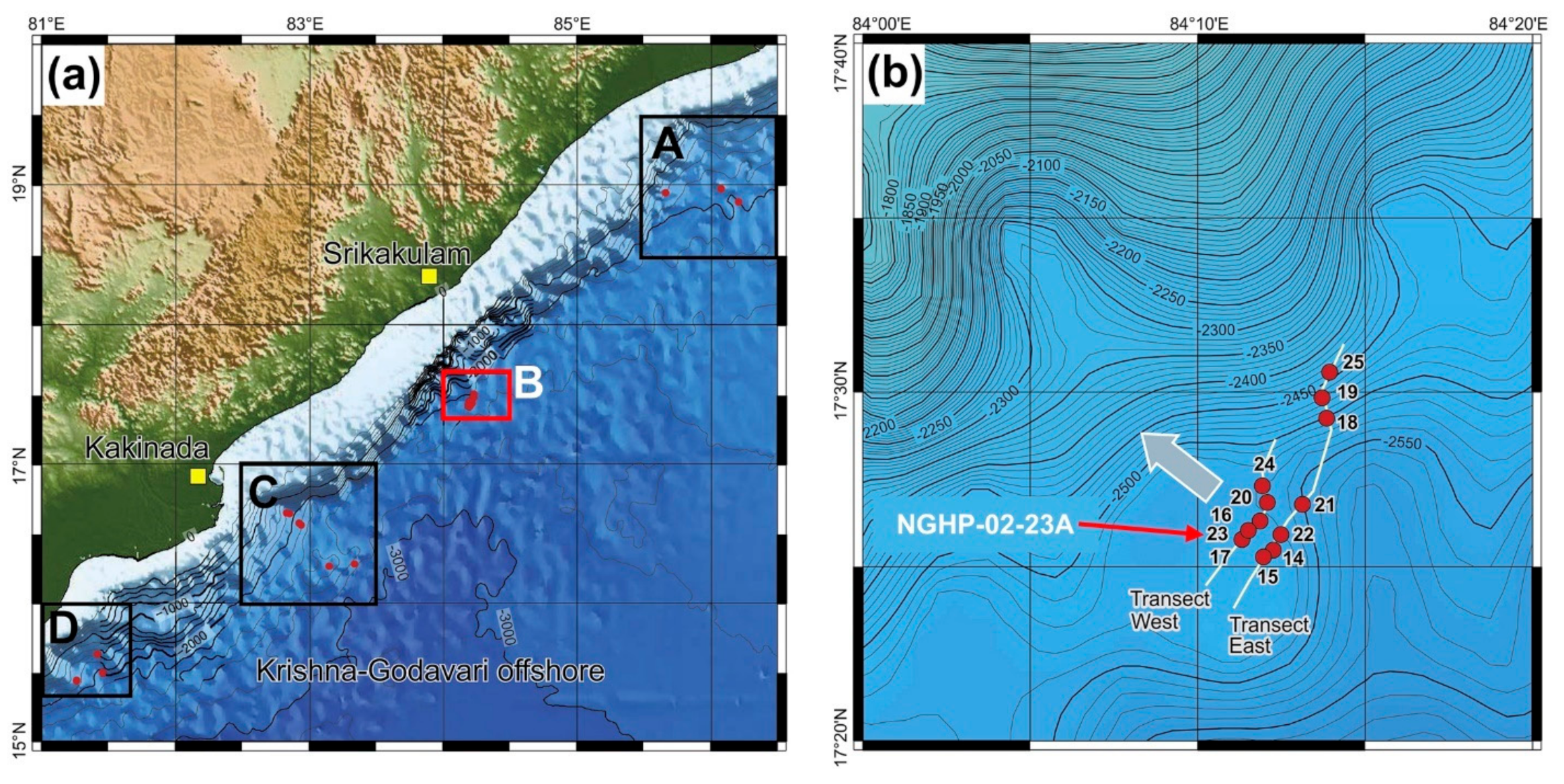


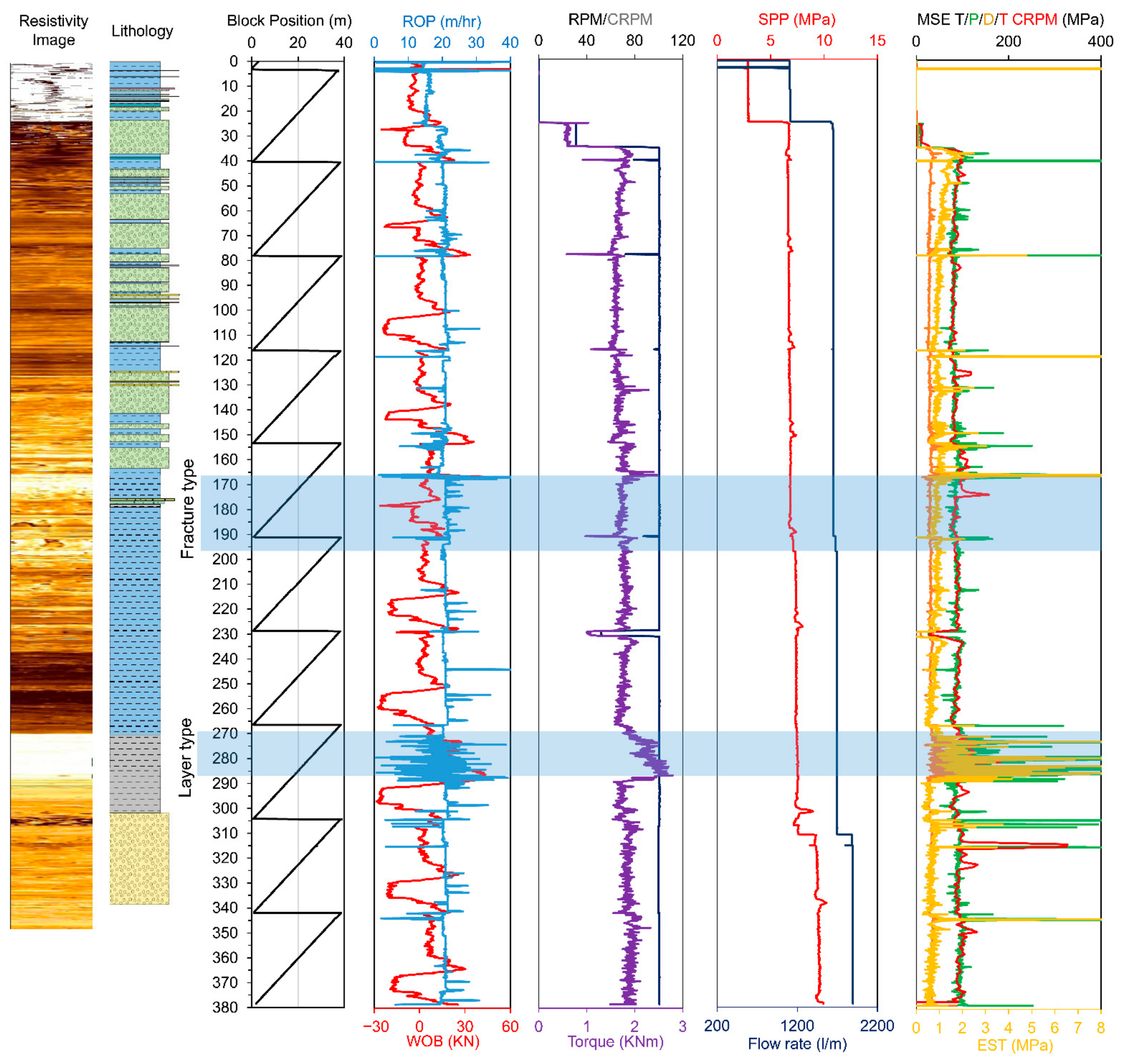

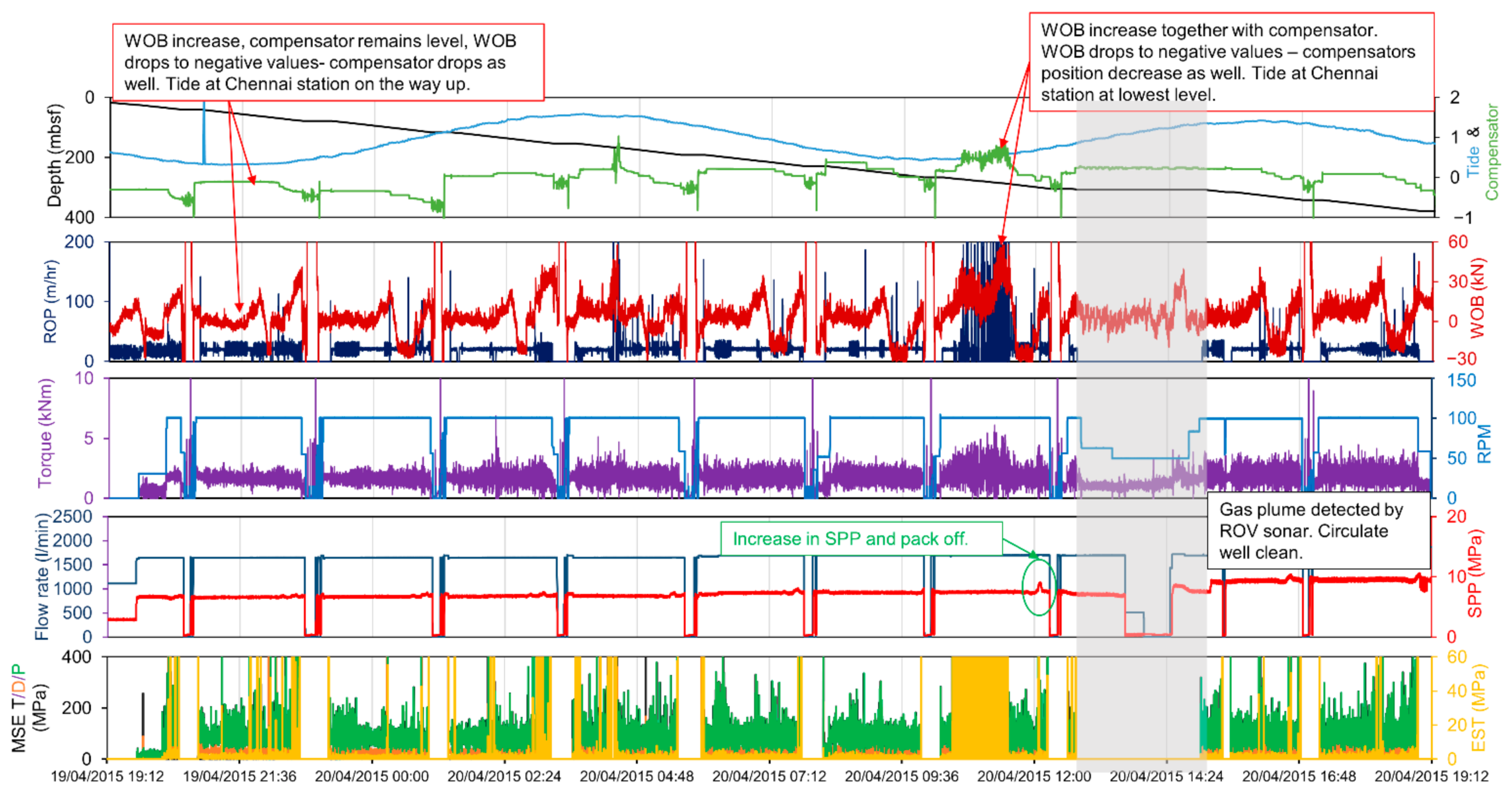
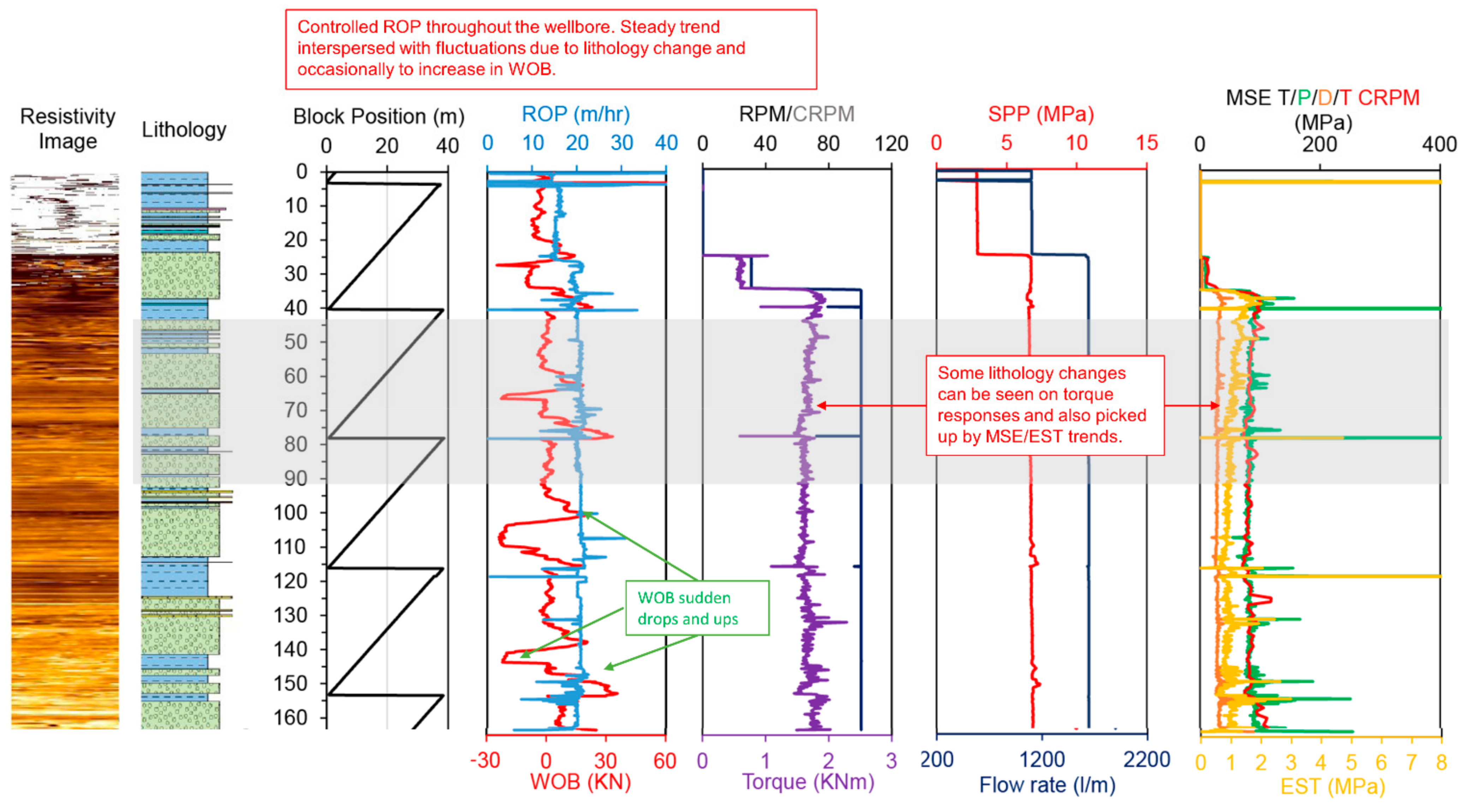




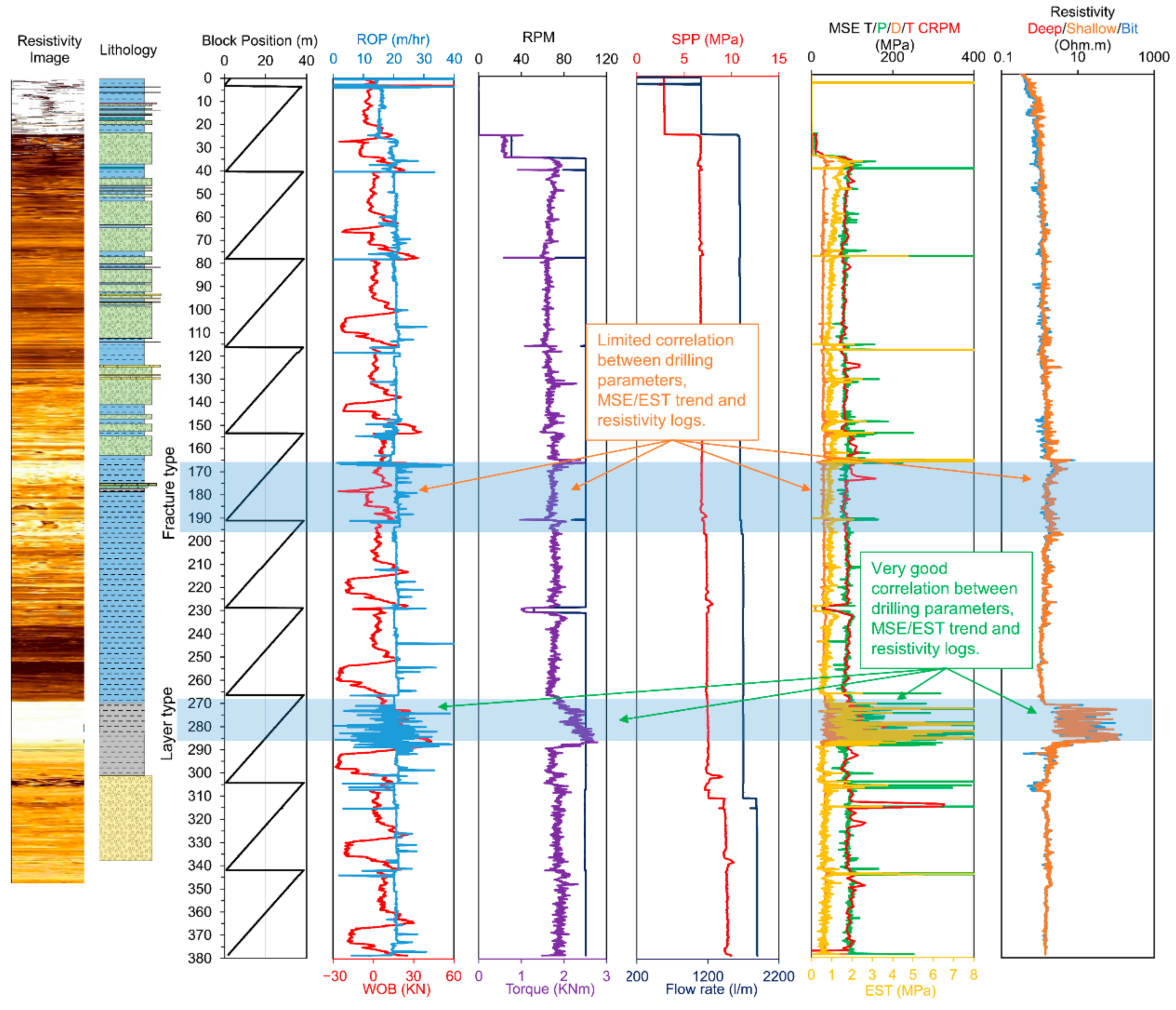
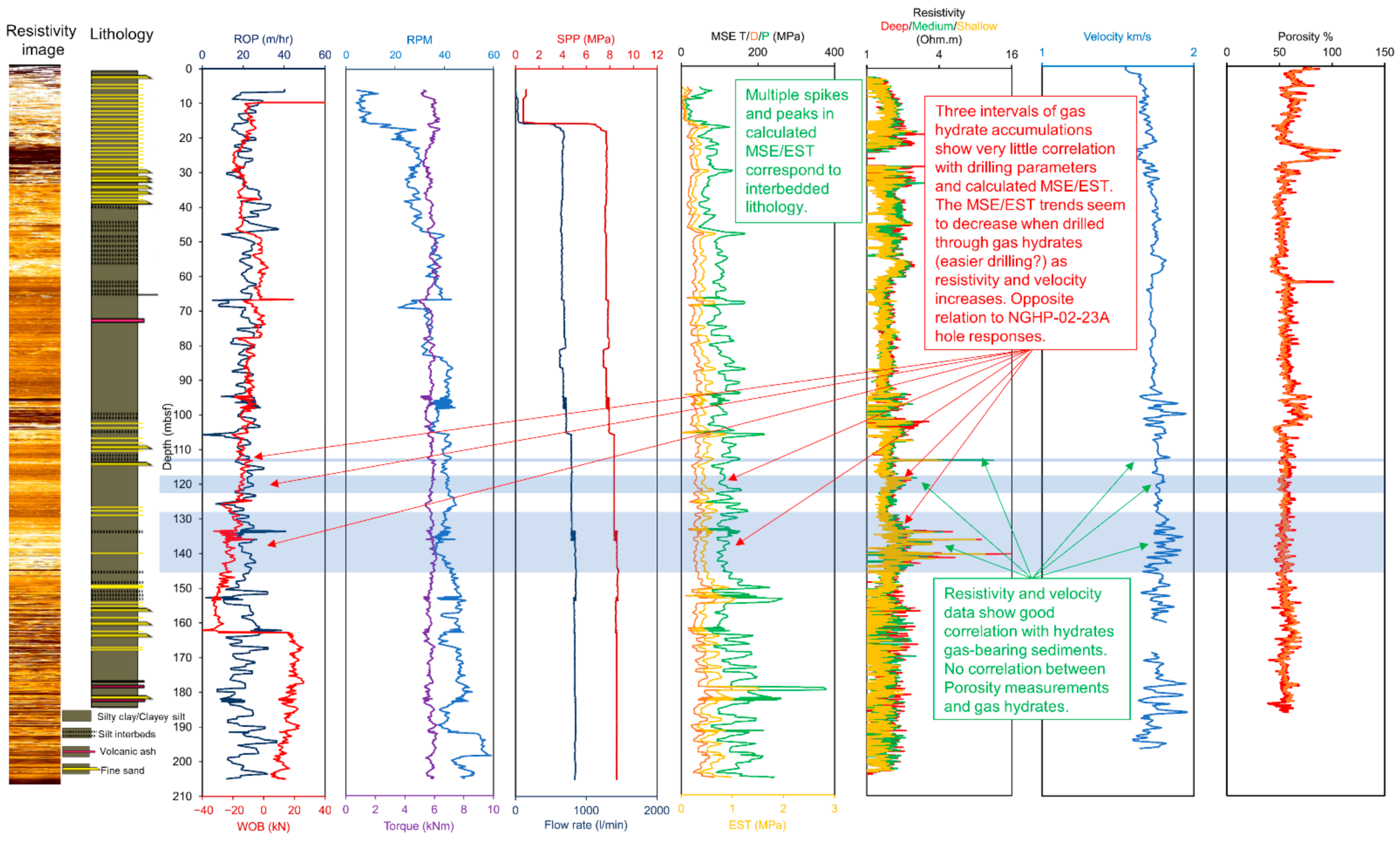
| Drilling Parameter | Type | Purpose | Unit |
|---|---|---|---|
| Revolution per minute (RPM) | Measured | To rotate and move the drill pipe with attached bit in order to cut the rock. Surface revolutions per minute (RPM). | Revolutions per minute |
| Torque (TRQ)—rotary torque (the rotational equivalent of linear force) | Measured | Torque changes are related to either formation lithology or downhole drilling problems, such as pipe stick/slip or motor stalling. | Newton meter (Nm) or pound-foot (lbf-ft) |
| Hookload (HKLD) | Measured | Total weight of drill pipe, bottom hole assembly, bit, and block weight. Data gathered from this sensor correlate with potential downhole problems, such as kicks or stuck pipes. | Newton (N), kilo Newton (kN) or pounds (lbs), kilopounds (klbs) |
| Weight on Bit (WOB) | Measured | Provide information on how much load (suspended weight of the drill pipe, bottom hole assembly, bit) is applied to the bottom of the hole. | Newton (N), kilo Newton (kN) or pounds (lbs), kilopounds (klbs) |
| Standpipe Pressure (SPP) | Measured | Pressure-tracking sensors are used mainly to monitor surface pressure being applied downhole. Data gathered from these sensors are used either to validate calculated values or to confirm potential downhole problems, such as washouts, kicks, or loss of circulation. | Megapascal (MPa) or pound per square inch (psi) |
| Rate of Penetration (ROP) | Measured/Calculated | Speed of drilling. Measures/calculates the distance of rock drilled per time unit. Excellent trending tool for detecting changes in lithology, kicks, and washouts. | Meters per hour (m/h) or feet per hour (ft/h) |
Publisher’s Note: MDPI stays neutral with regard to jurisdictional claims in published maps and institutional affiliations. |
© 2022 by the authors. Licensee MDPI, Basel, Switzerland. This article is an open access article distributed under the terms and conditions of the Creative Commons Attribution (CC BY) license (https://creativecommons.org/licenses/by/4.0/).
Share and Cite
Wspanialy, A.; Kyaw, M. Surface Drilling Parameters and Drilling Optimization Techniques: Are They Useful Tools in Gas Hydrate Detection? Energies 2022, 15, 4635. https://doi.org/10.3390/en15134635
Wspanialy A, Kyaw M. Surface Drilling Parameters and Drilling Optimization Techniques: Are They Useful Tools in Gas Hydrate Detection? Energies. 2022; 15(13):4635. https://doi.org/10.3390/en15134635
Chicago/Turabian StyleWspanialy, Adam, and Moe Kyaw. 2022. "Surface Drilling Parameters and Drilling Optimization Techniques: Are They Useful Tools in Gas Hydrate Detection?" Energies 15, no. 13: 4635. https://doi.org/10.3390/en15134635







